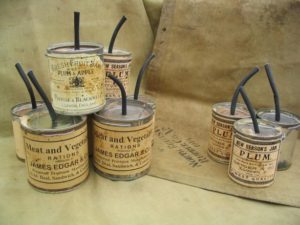Wednesday February 27th, 1918
Ditto
Relieved by the Fusiliers
While Frank won’t have heard yet, the Battalion is going to be replaced on the front line at the beginning of March. Relief is coming by way of the 12th Battalion, Lancashire Fusiliers from the 65th Infantry Brigade.
Jam for the Troops
Frank is still hungry. One item that hasn’t featured on his menu for a while seems to be ‘bread and jam’ – which he enjoys for tea but not for dinner. Therefore, an item that piqued my interest appeared in The Times newspaper on January 7th, 1918 under the regular feature ‘Imperial & Foreign News Items’ was as follows:
‘Negotiations are pending for the sale to the US of Australia’s surplus jam output after the sale of 12,000,000 lb to Great Britain.’
Obviously we know that bread and jam feature heavily on the menu of the troops. However, 12 million pounds imported to Britain from Australia seems an incomprehensible amount – to manufacture as well as consume!
Not so, according to author Barbara Santich. Apparently jam making was one of Australia’s earliest food industries, starting in Tasmania in the 1830s. Within a decade, Tasmania was exporting its jam as far afield as Mauritius and South Africa. Ten years later, it is made even more exportable, by being put into tins rather than bottles. This jam mania even attracted the attention of Anthony Trollope who, in 1873, commented ‘The Australian world is essentially a jam-consuming world’ and went on ‘…Tasmania ought to make jam for all the world’.¹
Over time jam manufacture was expanded to mainland Australia, particularly Queensland which had huge fruit harvests. Santich writes, ‘…the problem of a subsequent surplus of jam was conveniently solved by persuading the Imperial forces to requisition nearly 2,000 tons during WWI’.² By the way, this is much less than the amount The Times reported.
Jam Tins for the Enemy

Long before the Mills bomb became widely available, soldiers, who were unhappy with the Mark 1 British grenade or who couldn’t get hold of any, often resorted to crafting their own.
These were known as ‘Jam Tin’ bombs – because that is what they were made from – and are illustrated here.
The rations of jam for the troops, meant there were a lot of empty jam tins. These, stuffed with gun cotton or dynamite and a fuse, were used extensively in the early campaigns of the war, including Gallipoli.³ Waste not, want not!
13th (Service) Battalion War Diary – 27th February 1918 – No 1 Sector, Minden Camp
Our artillery was fairly active all day, enemy retaliated on batteries and the usual places in the Sector. In response to our trench mortars which fired 6 shells on O1, the enemy fired 13 back. 5 or 6 of our planes carried out a bombing raid on enemy dumps etc at about 17:00 hrs. At 13:10 hrs two enemy planes passed over our lines on their way home. Two more enemy planes passed over at 16:20 hrs. Usual patrols had nothing to report. Enemy snipers were almost inactive during the night. 1 OR transferred from 9th King’s Own Royal Liverpool Regiment in accordance with 3rd Ech BLK/A1/19804 and is taken on effective strength from 25-2-18. 1 OR (reinforcement) having joined is taken on effective strength from 25-2-18. Operation Order No 33 (Appendix No 3) issued at 20:30 hrs. The Battalion will be relieved on the night of the 1st/2nd March by the 12th Battalion, Lancashire Fusliers.
References & Further Reading
¹ ‘Australia and New Zealand’ by Anthony Trollope, Volume II, pages 38 & 51
² ‘Bold Palates: Australia’s Gastronomic Heritage’ by Barbara Santich, page 254
³ ‘Weapons of War – Grenades‘ in First World War.com
* ‘Jam-Tin bomb‘ image copyright of Tommy’s Pack Fillers


